2018 TOYOTA TUNDRA 4WD
[x] Cancel search: 4WDPage 93 of 672

932. Instrument cluster
2
Instrument cluster
*1: These lights turn on when the engine switch is turned to the “ON” positionto indicate that a system check is being performed. They will turn off after
the engine is started, or after a few seconds. There may be a m alfunction
in a system if the lights do not come on, or if the lights do n ot turn off. Have
the vehicle inspected by your Toyota dealer for details.
*2: The light flashes to indicate that the system is operating. Front fog light indicator
(
P. 216)
*1
“TRAC OFF” indicator
(P. 302)
*1, 5
“AIR BAG ON” and
“AIR BAG OFF”
indicators ( P. 50)
*9
“RCTA” indicator
(P. 286)
Security indicator
( P. 76, 85)
*6, 9
Radar cruise control
indicator ( P. 252)
*1“AUTO LSD” indicator
(P. 299, 302)
*1, 2Slip indicator
( P. 302)*1, 8, 9
PCS warning light
(P. 235)
*1VSC off indicator
(P. 299, 302)
(4WD models)
“4HI” indicator ( P. 296)
“TOW HAUL” indicator
( P. 200)
(4WD models)
“4LO” indicator ( P. 296)
*9“BSM” indicator
(P. 286)*6
(Green)
Trailer connection
indicator ( P. 308)
*3, 4, 9
BSM outside rear view
mirror indicator
(P. 286)
*6, 7
Low outside temperature
indicator
Page 161 of 672
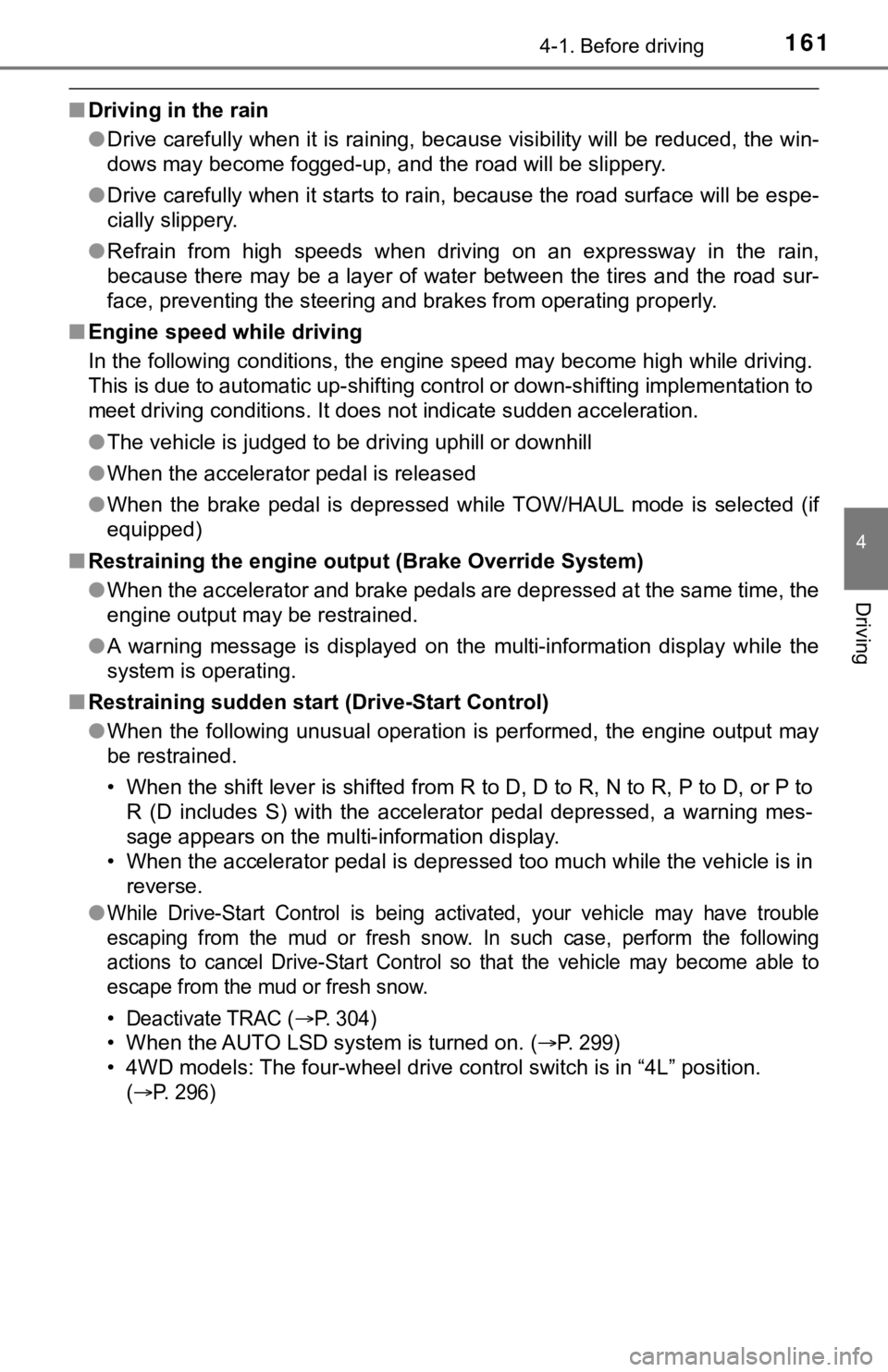
1614-1. Before driving
4
Driving
■Driving in the rain
●Drive carefully when it is raining, because visibility will be reduced, the win-
dows may become fogged-up, and the road will be slippery.
● Drive carefully when it starts to rain, because the road surface will be espe-
cially slippery.
● Refrain from high speeds when driving on an expressway in the r ain,
because there may be a layer of water between the tires and the road sur-
face, preventing the steering and brakes from operating properl y.
■ Engine speed while driving
In the following conditions, the engine speed may become high w hile driving.
This is due to automatic up-shifting control or down-shifting implementation to
meet driving conditions. It does not indicate sudden acceleration.
● The vehicle is judged to be driving uphill or downhill
● When the accelerator pedal is released
● When the brake pedal is depressed while TOW/HAUL mode is select ed (if
equipped)
■ Restraining the engine out put (Brake Override System)
● When the accelerator and brake pedals are depressed at the same time, the
engine output may be restrained.
● A warning message is displayed on the multi-information display while the
system is operating.
■ Restraining sudden start (Drive-Start Control)
● When the following unusual operation is performed, the engine o utput may
be restrained.
• When the shift lever is shifted from R to D, D to R, N to R, P to D, or P to
R (D includes S) with the accelerator pedal depressed, a warnin g mes-
sage appears on the multi-information display.
• When the accelerator pedal is depressed too much while the veh icle is in
reverse.
●
While Drive-Start Control is being activated, your vehicle may have trouble
escaping from the mud or fresh snow. In such case, perform the following
actions to cancel Drive-Start Co ntrol so that the vehicle may become able to
escape from the mud or fresh snow.
•Deactivate TRAC (P. 304)
• When the AUTO LSD system is turned on. (P. 299)
• 4WD models: The four-wheel drive control switch is in “4L” pos ition.
(P. 296)
Page 166 of 672
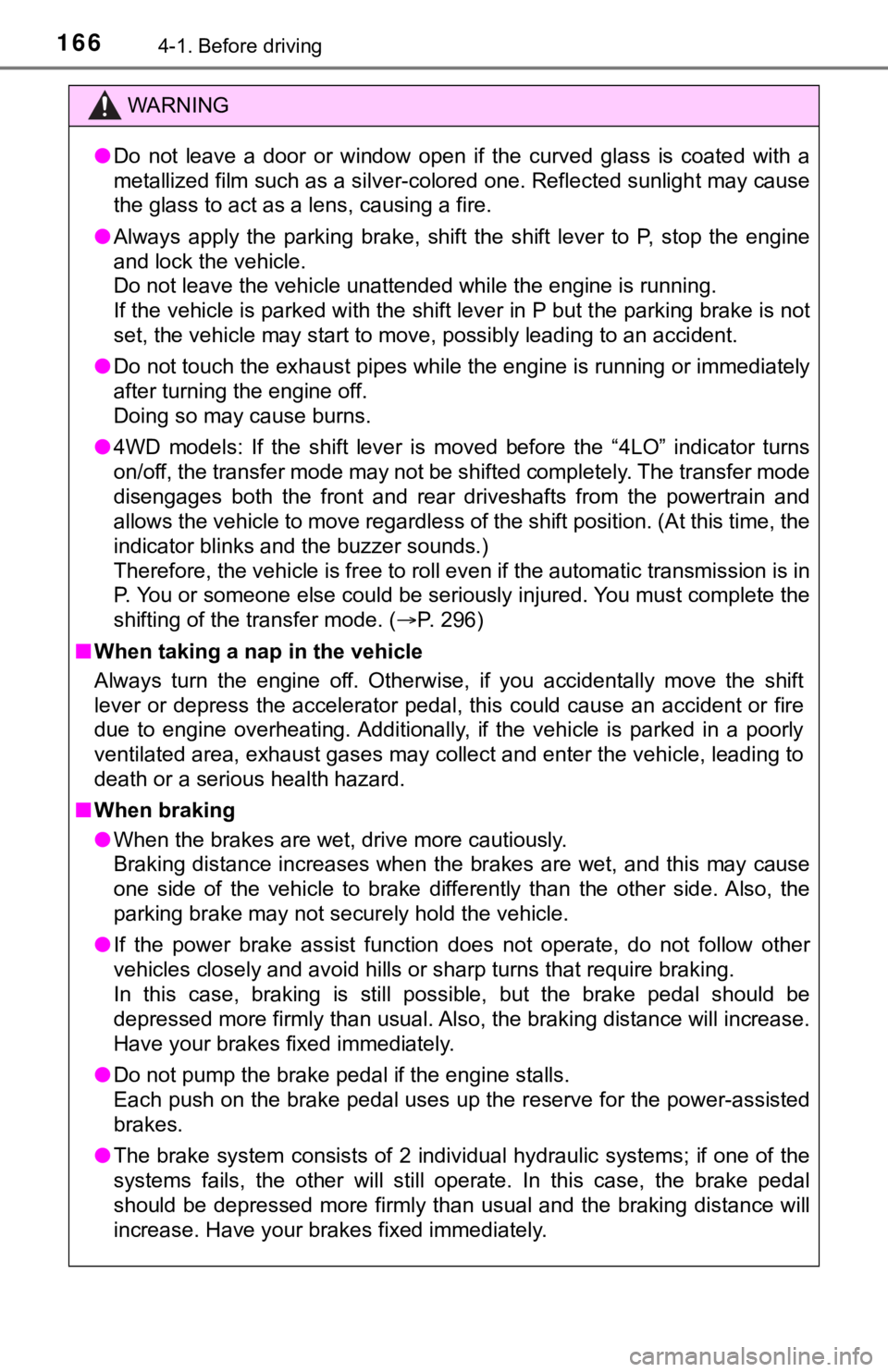
1664-1. Before driving
WARNING
●Do not leave a door or window open if the curved glass is coate d with a
metallized film such as a silver-colored one. Reflected sunligh t may cause
the glass to act as a lens, causing a fire.
● Always apply the parking brake, shift the shift lever to P, stop the engine
and lock the vehicle.
Do not leave the vehicle unattended while the engine is running .
If the vehicle is parked with the shift lever in P but the park ing brake is not
set, the vehicle may start to move, possibly leading to an acci dent.
● Do not touch the exhaust pipes while the engine is running or i mmediately
after turning the engine off.
Doing so may cause burns.
● 4WD models: If the shift lever is moved before the “4LO” indicator turns
on/off, the transfer mode may not be shifted completely. The tr ansfer mode
disengages both the front and rear driveshafts from the powertrain and
allows the vehicle to move regardless of the shift position. (A t this time, the
indicator blinks and the buzzer sounds.)
Therefore, the vehicle is free to roll even if the automatic transmission is in
P. You or someone else could be seriously injured. You must complete the
shifting of the transfer mode. ( P. 296)
■ When taking a nap in the vehicle
Always turn the engine off. Otherwise, if you accidentally move the shift
lever or depress the accelerator pedal, this could cause an acc ident or fire
due to engine overheating. Additionally, if the vehicle is park ed in a poorly
ventilated area, exhaust gases may collect and enter the vehicl e, leading to
death or a serious health hazard.
■ When braking
● When the brakes are wet, drive more cautiously.
Braking distance increases when the brakes are wet, and this ma y cause
one side of the vehicle to brake differently than the other sid e. Also, the
parking brake may not securely hold the vehicle.
● If the power brake assist function does not operate, do not fol low other
vehicles closely and avoid hills or sharp turns that require br aking.
In this case, braking is still possible, but the brake pedal sh ould be
depressed more firmly than usual. Also, the braking distance wi ll increase.
Have your brakes fixed immediately.
● Do not pump the brake pedal if the engine stalls.
Each push on the brake pedal uses up the reserve for the power-assisted
brakes.
● The brake system consists of 2 individual hydraulic systems; if one of the
systems fails, the other will still operate. In this case, the brake pedal
should be depressed more firmly than usual and the braking dist ance will
increase. Have your brakes fixed immediately.
Page 167 of 672
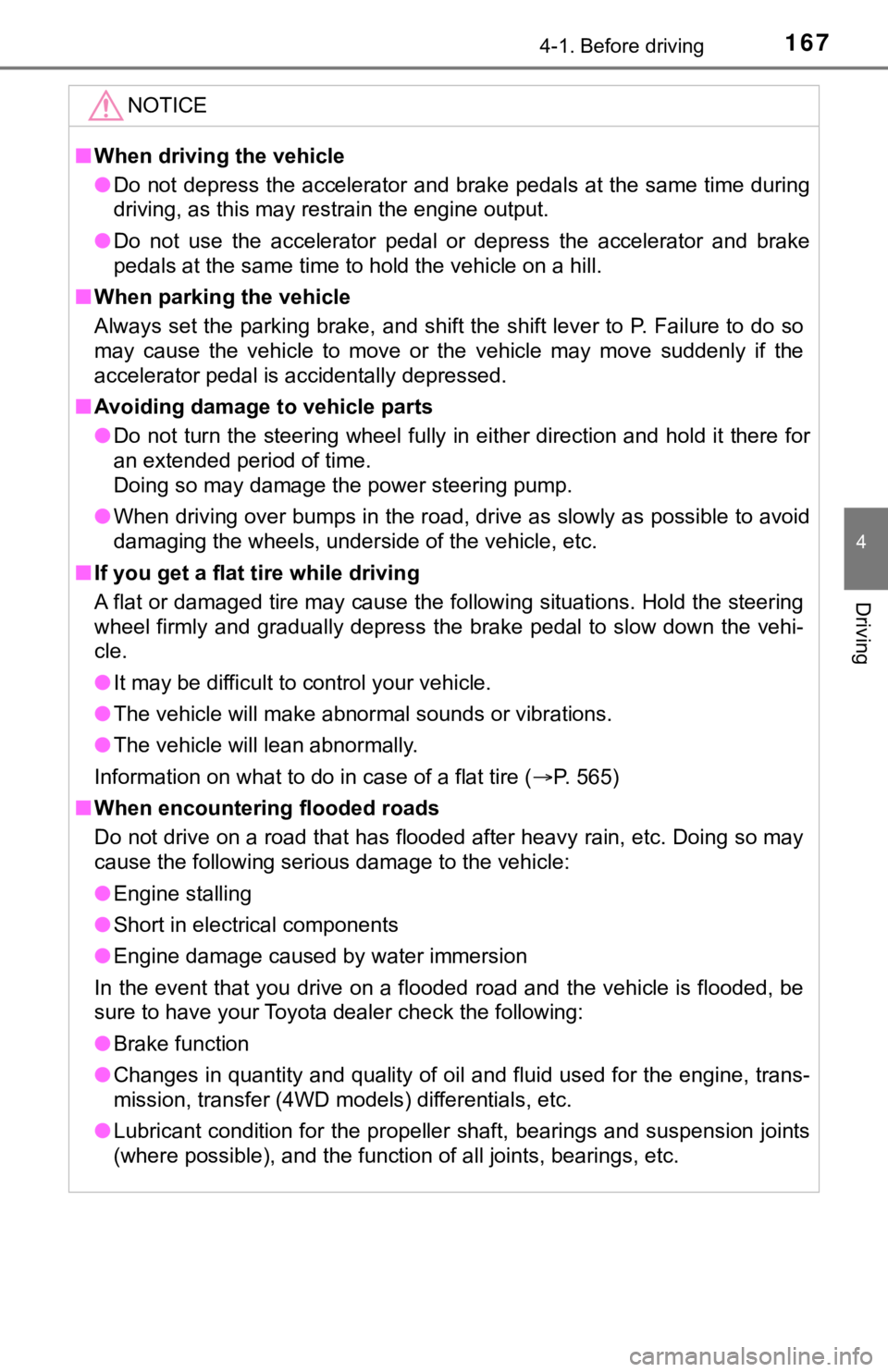
1674-1. Before driving
4
Driving
NOTICE
■When driving the vehicle
● Do not depress the accelerator and brake pedals at the same tim e during
driving, as this may restrain the engine output.
● Do not use the accelerator pedal or depress the accelerator and brake
pedals at the same time to hold the vehicle on a hill.
■ When parking the vehicle
Always set the parking brake, and shift the shift lever to P. F ailure to do so
may cause the vehicle to move or the vehicle may move suddenly if the
accelerator pedal is accidentally depressed.
■ Avoiding damage to vehicle parts
● Do not turn the steering wheel fully in either direction and ho ld it there for
an extended period of time.
Doing so may damage the power steering pump.
● When driving over bumps in the road, drive as slowly as possibl e to avoid
damaging the wheels, underside of the vehicle, etc.
■ If you get a flat tire while driving
A flat or damaged tire may cause the following situations. Hold the steering
wheel firmly and gradually depress the brake pedal to slow down the vehi-
cle.
● It may be difficult to control your vehicle.
● The vehicle will make abnormal sounds or vibrations.
● The vehicle will lean abnormally.
Information on what to do in case of a flat tire ( P. 565)
■ When encountering flooded roads
Do not drive on a road that has flooded after heavy rain, etc. Doing so may
cause the following serious damage to the vehicle:
● Engine stalling
● Short in electrical components
● Engine damage caused by water immersion
In the event that you drive on a flooded road and the vehicle i s flooded, be
sure to have your Toyota dealer check the following:
● Brake function
● Changes in quantity and quality of oil and fluid used for the engine, trans-
mission, transfer (4WD models) differentials, etc.
● Lubricant condition for the propeller shaft, bearings and suspe nsion joints
(where possible), and the function of all joints, bearings, etc .
Page 177 of 672
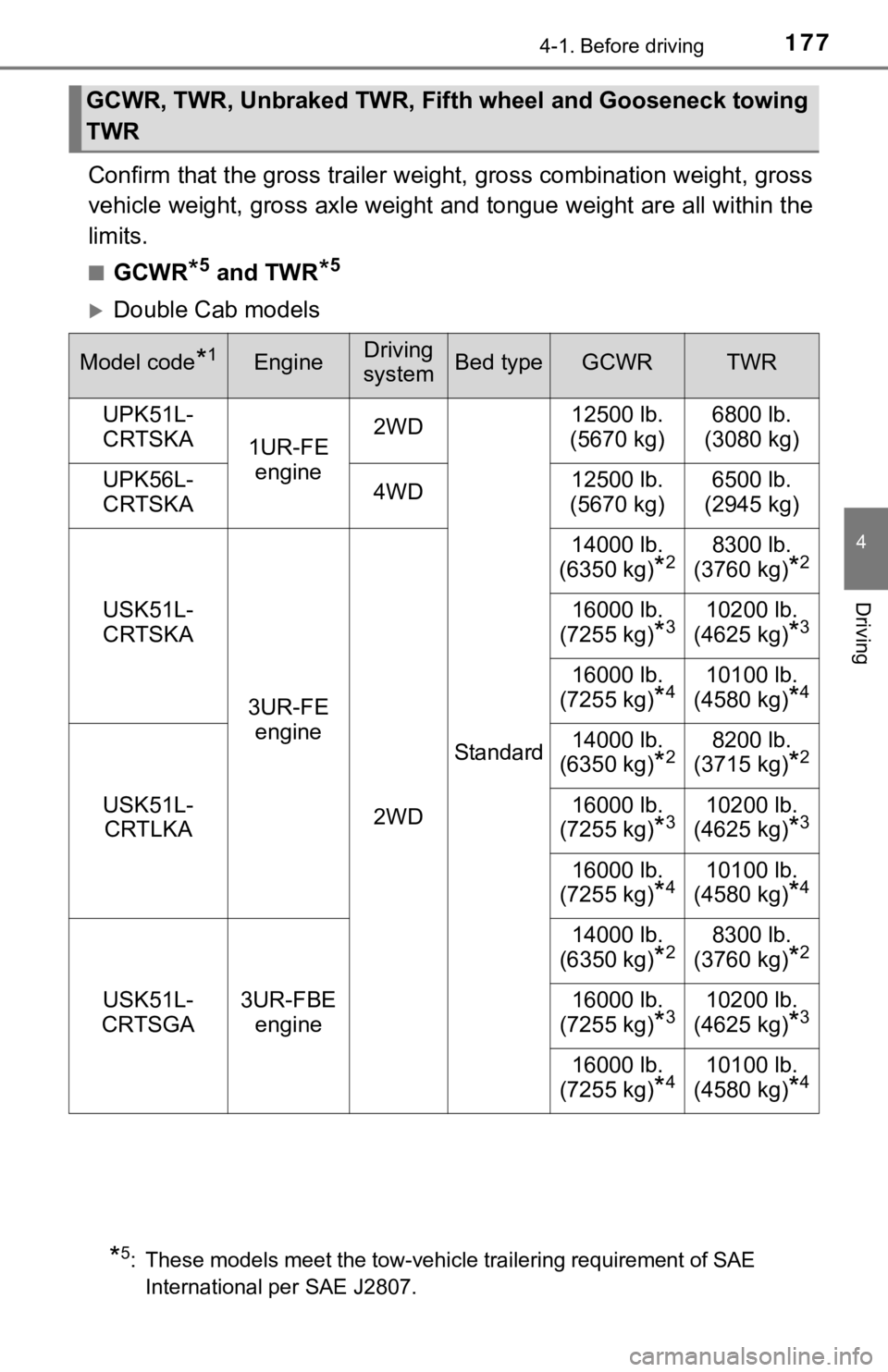
1774-1. Before driving
4
Driving
Confirm that the gross trailer weight, gross combination weight, gross
vehicle weight, gross axle weight and tongue weight are all within the
limits.
■GCWR*5 and TWR*5
Double Cab models
GCWR, TWR, Unbraked TWR, Fifth wheel and Gooseneck towing
TWR
*5: These models meet the tow-vehicle trailering requirement of SAE International per SAE J2807.
Model code*1EngineDriving
systemBed typeGCWRTWR
UPK51L- CRTSKA 1UR-FE
engine 2WD
Standard 12500 lb.
(5670 kg) 6800 lb.
(3080 kg)
UPK56L- CRTSKA 4WD12500 lb.
(5670 kg) 6500 lb.
(2945 kg)
USK51L- CRTSKA
3UR-FE engine
2WD 14000 lb.
(6350 kg)
*28300 lb.
(3760 kg)
*2
16000 lb.
(7255 kg)
*310200 lb.
(4625 kg)
*3
16000 lb.
(7255 kg)
*410100 lb.
(4580 kg)
*4
USK51L-
CRTLKA 14000 lb.
(6350 kg)
*28200 lb.
(3715 kg)
*2
16000 lb.
(7255 kg)
*310200 lb.
(4625 kg)
*3
16000 lb.
(7255 kg)
*410100 lb.
(4580 kg)
*4
USK51L-
CRTSGA 3UR-FBE
engine 14000 lb.
(6350 kg)
*28300 lb.
(3760 kg)
*2
16000 lb.
(7255 kg)
*310200 lb.
(4625 kg)
*3
16000 lb.
(7255 kg)
*410100 lb.
(4580 kg)
*4
Page 178 of 672
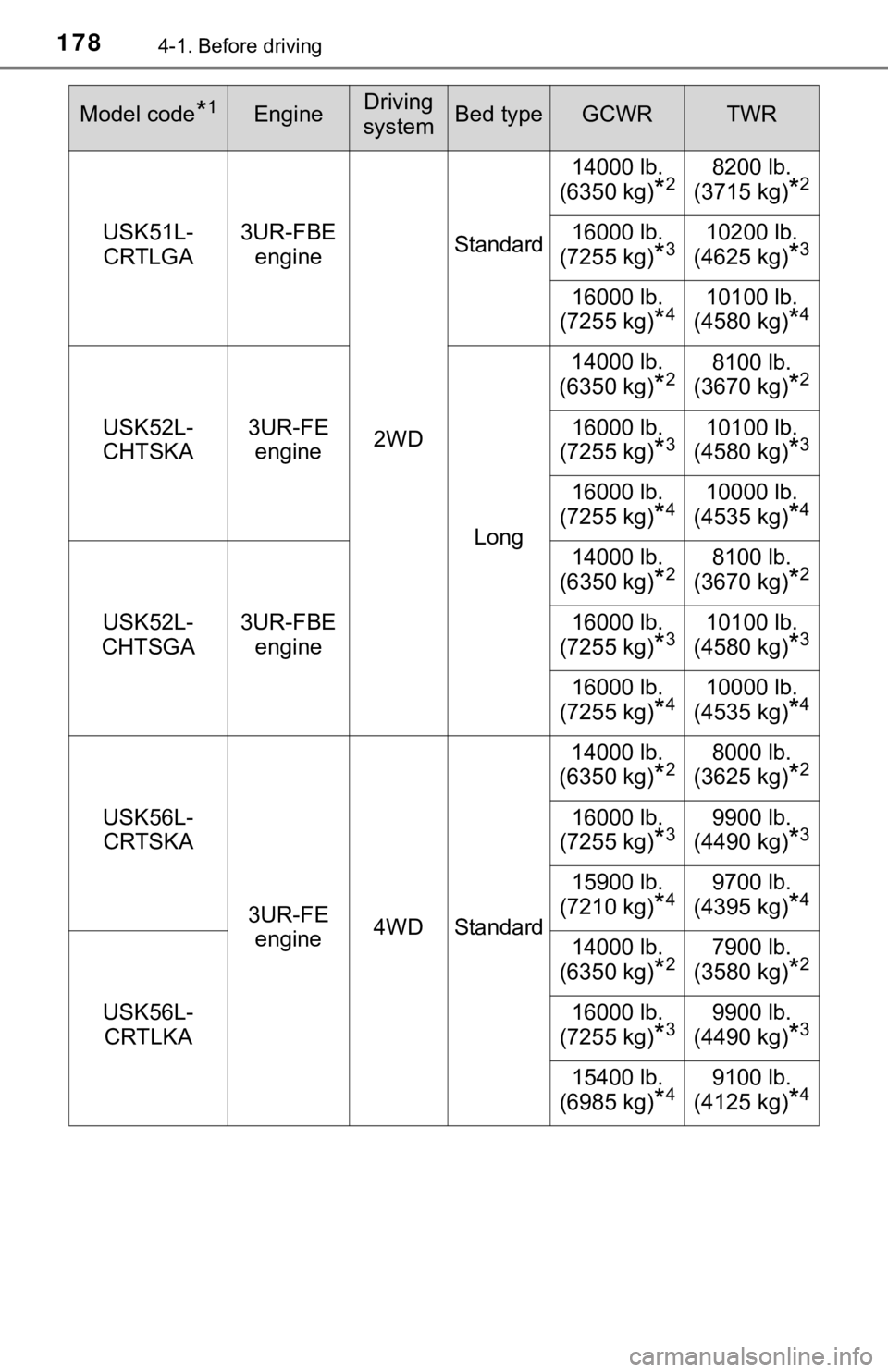
1784-1. Before driving
USK51L-CRTLGA 3UR-FBE
engine
2WDStandard
14000 lb.
(6350 kg)
*28200 lb.
(3715 kg)
*2
16000 lb.
(7255 kg)
*310200 lb.
(4625 kg)
*3
16000 lb.
(7255 kg)
*410100 lb.
(4580 kg)
*4
USK52L-
CHTSKA 3UR-FE
engine
Long14000 lb.
(6350 kg)
*28100 lb.
(3670 kg)
*2
16000 lb.
(7255 kg)
*310100 lb.
(4580 kg)
*3
16000 lb.
(7255 kg)
*410000 lb.
(4535 kg)
*4
USK52L-
CHTSGA 3UR-FBE
engine 14000 lb.
(6350 kg)
*28100 lb.
(3670 kg)
*2
16000 lb.
(7255 kg)
*310100 lb.
(4580 kg)
*3
16000 lb.
(7255 kg)
*410000 lb.
(4535 kg)
*4
USK56L- CRTSKA
3UR-FE engine 4WD Standard 14000 lb.
(6350 kg)
*28000 lb.
(3625 kg)
*2
16000 lb.
(7255 kg)
*39900 lb.
(4490 kg)
*3
15900 lb.
(7210 kg)
*49700 lb.
(4395 kg)
*4
USK56L- CRTLKA 14000 lb.
(6350 kg)
*27900 lb.
(3580 kg)
*2
16000 lb.
(7255 kg)
*39900 lb.
(4490 kg)
*3
15400 lb.
(6985 kg)
*49100 lb.
(4125 kg)
*4
Model code*1EngineDriving
systemBed typeGCWRTWR
Page 179 of 672
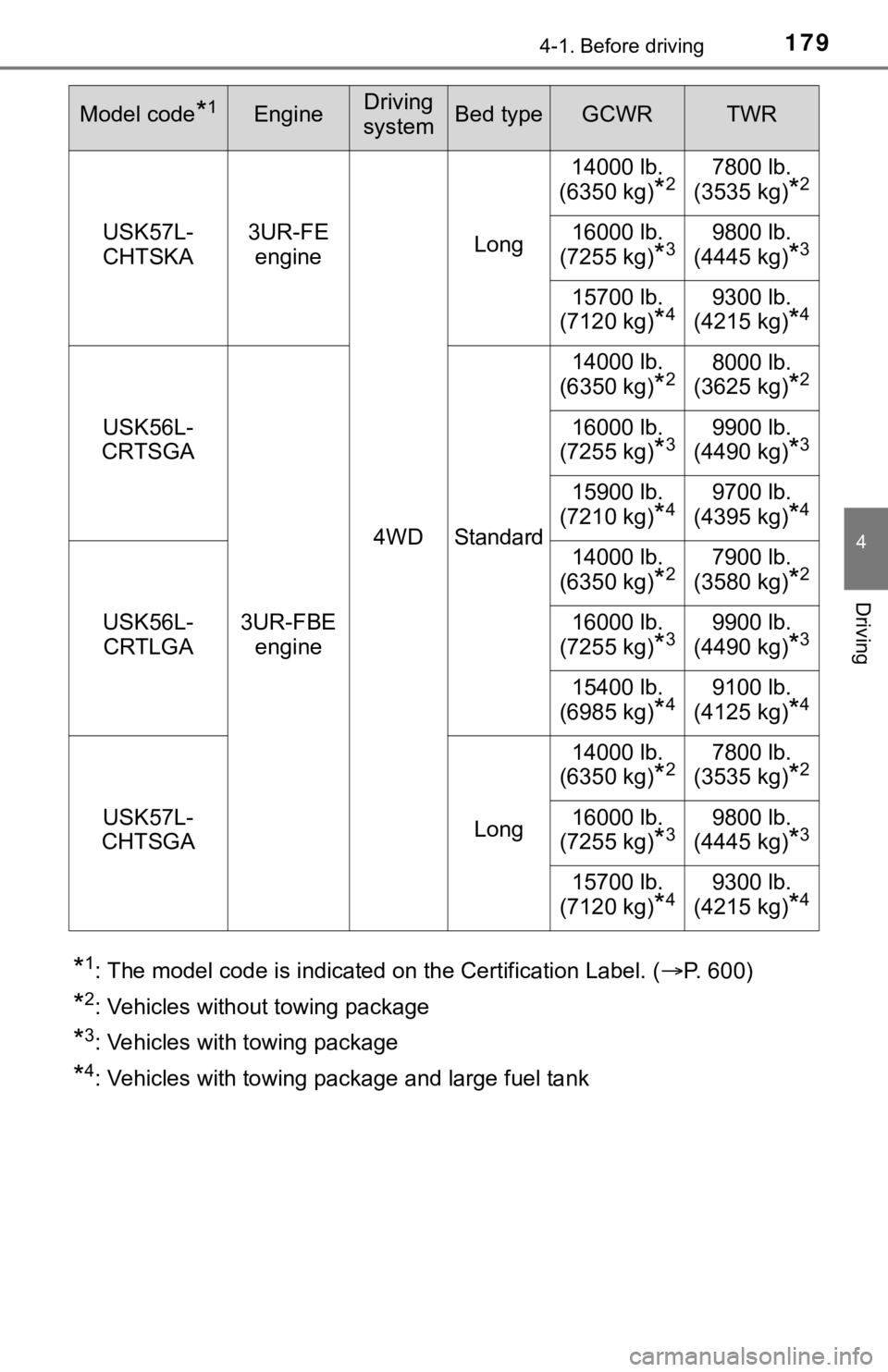
1794-1. Before driving
4
Driving
*1: The model code is indicated on the Certification Label. (P. 600)
*2: Vehicles without towing package
*3: Vehicles with towing package
*4: Vehicles with towing package and large fuel tankUSK57L-
CHTSKA
3UR-FE
engine
4WDLong
14000 lb.
(6350 kg)
*27800 lb.
(3535 kg)
*2
16000 lb.
(7255 kg)
*39800 lb.
(4445 kg)
*3
15700 lb.
(7120 kg)
*49300 lb.
(4215 kg)
*4
USK56L-
CRTSGA
3UR-FBE engine Standard14000 lb.
(6350 kg)
*28000 lb.
(3625 kg)
*2
16000 lb.
(7255 kg)
*39900 lb.
(4490 kg)
*3
15900 lb.
(7210 kg)
*49700 lb.
(4395 kg)
*4
USK56L- CRTLGA 14000 lb.
(6350 kg)
*27900 lb.
(3580 kg)
*2
16000 lb.
(7255 kg)
*39900 lb.
(4490 kg)
*3
15400 lb.
(6985 kg)
*49100 lb.
(4125 kg)
*4
USK57L-
CHTSGA Long14000 lb.
(6350 kg)
*27800 lb.
(3535 kg)
*2
16000 lb.
(7255 kg)
*39800 lb.
(4445 kg)
*3
15700 lb.
(7120 kg)
*49300 lb.
(4215 kg)
*4
Model code*1EngineDriving
systemBed typeGCWRTWR
Page 180 of 672
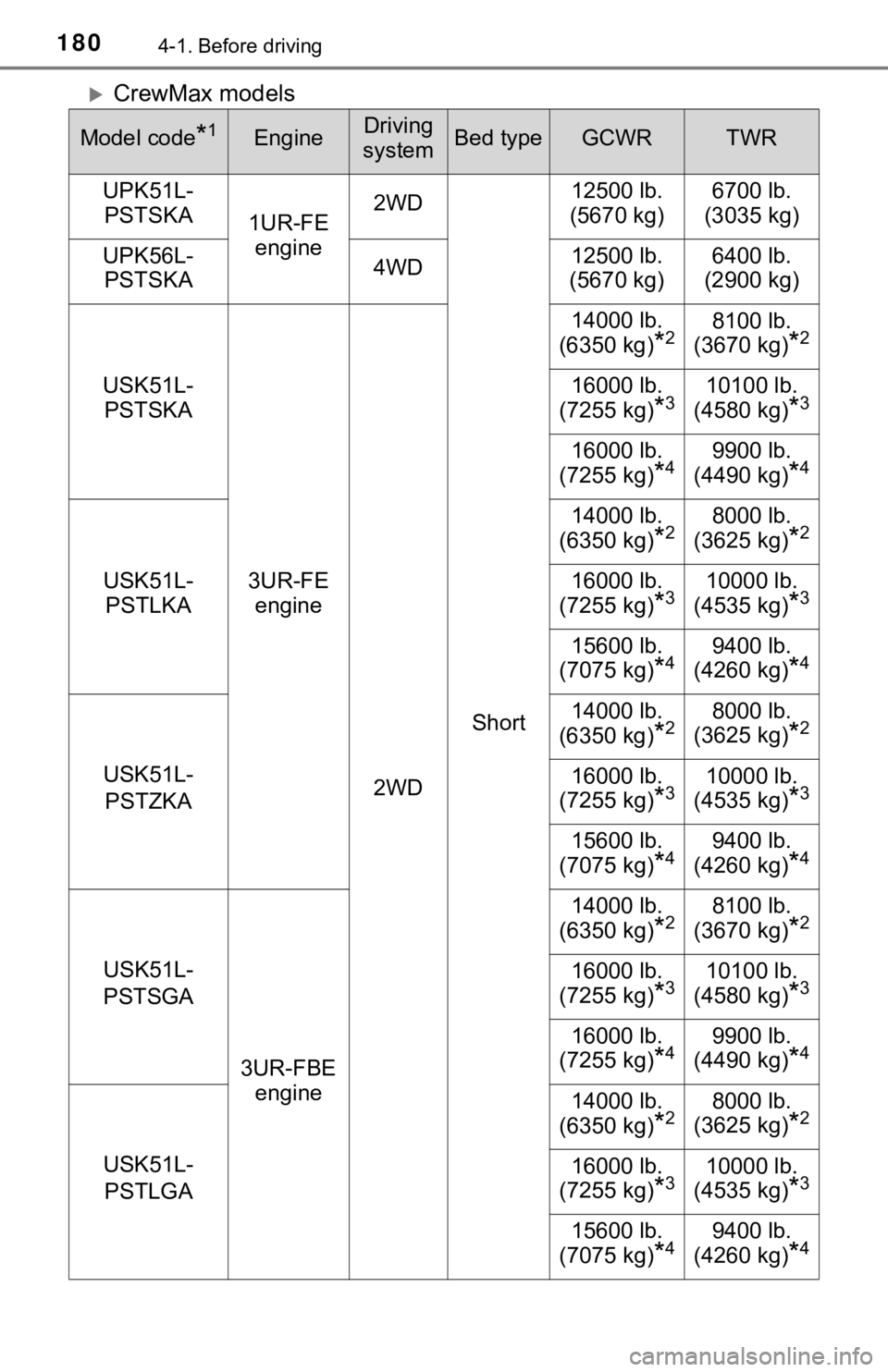
1804-1. Before driving
CrewMax models
Model code*1EngineDriving
systemBed typeGCWRTWR
UPK51L- PSTSKA 1UR-FE
engine 2WD
Short 12500 lb.
(5670 kg) 6700 lb.
(3035 kg)
UPK56L- PSTSKA 4WD
12500 lb.
(5670 kg) 6400 lb.
(2900 kg)
USK51L- PSTSKA
3UR-FE engine
2WD 14000 lb.
(6350 kg)
*28100 lb.
(3670 kg)
*2
16000 lb.
(7255 kg)
*310100 lb.
(4580 kg)
*3
16000 lb.
(7255 kg)
*49900 lb.
(4490 kg)
*4
USK51L- PSTLKA 14000 lb.
(6350 kg)
*28000 lb.
(3625 kg)
*2
16000 lb.
(7255 kg)
*310000 lb.
(4535 kg)
*3
15600 lb.
(7075 kg)
*49400 lb.
(4260 kg)
*4
USK51L-
PSTZKA 14000 lb.
(6350 kg)
*28000 lb.
(3625 kg)
*2
16000 lb.
(7255 kg)
*310000 lb.
(4535 kg)
*3
15600 lb.
(7075 kg)
*49400 lb.
(4260 kg)
*4
USK51L-
PSTSGA
3UR-FBE engine 14000 lb.
(6350 kg)
*28100 lb.
(3670 kg)
*2
16000 lb.
(7255 kg)
*310100 lb.
(4580 kg)
*3
16000 lb.
(7255 kg)
*49900 lb.
(4490 kg)
*4
USK51L-
PSTLGA 14000 lb.
(6350 kg)
*28000 lb.
(3625 kg)
*2
16000 lb.
(7255 kg)
*310000 lb.
(4535 kg)
*3
15600 lb.
(7075 kg)
*49400 lb.
(4260 kg)
*4